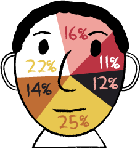Archival Notice
This is an archive page that is no longer being updated. It may contain outdated information and links may no longer function as originally intended.
Home | Glossary | Resources | Help | Contact Us | Course Map
Population genetics is the study of the distribution of and change in allele frequencies under the influence of the four evolutionary forces: natural selection, genetic drift, mutation, and migration. Population structure is also taken into account.01
Descriptive statistics are used to summarize a collection of population data in a clear and concise manner. The collection of population data can be exhaustive and usually results in the accumulation of a considerable volume of information. The term "population" can be defined in many ways, but in the most common sense of the word, it is a collection of people or organisms of a particular species living in a geographic area.
In biology, a population generally denotes a group whose members breed primarily or solely among themselves. This is usually a result of a physical isolation, although biologically they could breed with any member of the species. A common misconception is that human populations fall into uniform groups with large biological differences, which lie along racial boundaries. Racial groups are not as easily defined. Depending on the classification, there can be between 3 and 200 races in the human population.02 Research has demonstrated that racial classifications are inadequate descriptors of the distribution of genetic variation in the human species.03 An alternative to classifying the human species by race is to divide them by ethnicity. Dividing populations along ethnic origins can present some of the same classification issues. The self-described ethnicity of an individual may be different from his or her familial origins. It is difficult to categorize population groups, and while neither race nor ethnicity is ideal, each is used to provide estimates of allele frequencies.
Additional Online Courses
- What Every First Responding Officer Should Know About DNA Evidence
- Collecting DNA Evidence at Property Crime Scenes
- DNA – A Prosecutor’s Practice Notebook
- Crime Scene and DNA Basics
- Laboratory Safety Programs
- DNA Amplification
- Population Genetics and Statistics
- Non-STR DNA Markers: SNPs, Y-STRs, LCN and mtDNA
- Firearms Examiner Training
- Forensic DNA Education for Law Enforcement Decisionmakers
- What Every Investigator and Evidence Technician Should Know About DNA Evidence
- Principles of Forensic DNA for Officers of the Court
- Law 101: Legal Guide for the Forensic Expert
- Laboratory Orientation and Testing of Body Fluids and Tissues
- DNA Extraction and Quantitation
- STR Data Analysis and Interpretation
- Communication Skills, Report Writing, and Courtroom Testimony
- Español for Law Enforcement
- Amplified DNA Product Separation for Forensic Analysts


